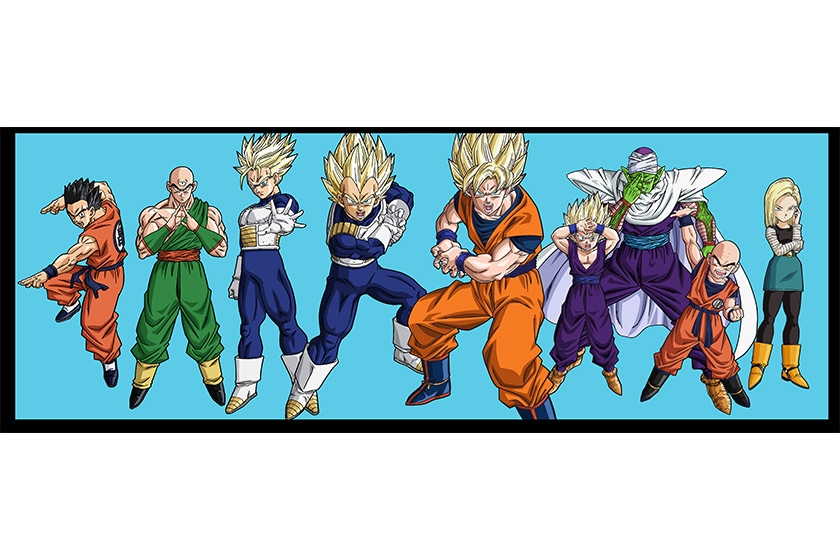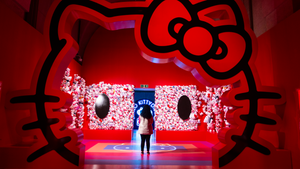Toei Animation is celebrating the milestone 30th anniversary of “Dragon Ball Z” and its immeasurable impact on catapulting anime across the globe.
February 14, 2019

Toei Animation has achieved the unfathomable–bringing a once-niche, obscure Japanese animation phenomenon known as “anime” stateside, solidifying the genre as a bonafide mainstay of American pop culture today.
Forever changing the landscape of animation consumption in the West is a monumental achievement that didn’t happen overnight. In fact, it took decades. And one major contributing factor to this shift was the undeniable popularity of Toei’s iconic “Dragon Ball” franchises, most notably, “Dragon Ball Z.”
2019 marks the landmark 30th anniversary of “Dragon Ball Z,” which Toei plans to celebrate via a host of major events, licensing deals, promotions, product launches and activations fit for a property of this magnitude.
The “Dragon Ball” franchise collectively has more than 800 episodes. Titles include “Dragon Ball” (153 episodes), “Dragon Ball Z” (291 episodes) and “Dragon Ball GT” (64 episodes), among others.
Turner’s Adult Swim currently airs “Dragon Ball Super,” which launched in 2017 and is aimed at a younger audience, as well as “Dragon Ball Z Kai,” a remastered, re-cut version of “Dragon Ball Z.”
“Dragon Ball Z” is the sequel to the original “Dragon Ball” anime series, inspired by the Japanese manga of the same title. It tells the story of Goku, who heroically fights and saves planet Earth from a slew of conquerors and warriors, including Vegeta and Frieza. The series focuses on Goku’s life as an adult, building on the character’s origin story, which was the basis of the original series.
“Dragon Ball Z” first aired on Japan’s Fuji TV on April 26, 1989–far before anime was even a blip on the radar in the West and nearly a decade before it hit the airwaves in the United States. Crossing over to eventually become a cult-classic seemed like a dreamy, far-fetched fantasy for the brand.
In the early years, Funimation, an entertainment company that specializes in the distribution of anime titles, was instrumental in bringing the property stateside. In fact, Funimation was founded by Gen Fukunaga in 1994 with the purpose of licensing the “Dragon Ball” franchise. Back then, Funimation also represented the “Dragon Ball” franchise, with the company holding a majority of the property rights to the series for the U.S. and Canada, including the rights for broadcast, home video and toys.
Cultural hurdles proved to be a massive challenge in bringing an anime property to North America in the ‘90s. Because anime was largely consumed by adults in Japan and often featured mature content, American broadcasters were reluctant. After all, animation in the U.S. was, at the time, largely aimed at children.
“The challenge in bringing the property to TV here was that there is broadcast Standards and Practices for each network,” says Lisa Yamatoya, senior manager, marketing and licensing, Toei Animation. “The series itself had some mature content, so we learned to accept that we would have to invest in different versions, such as a hard edit and a soft edit. We edited the actual animation, and we re-recorded it in other languages to make it suitable for different networks.
“In America, everybody thinks animation is for kids, but in Japan, people of all ages read manga, and the after-midnight animation shows have mature content,” adds Yamatoya. “I think to have the Japan team understand what needs to be done to sell in the U.S. is a huge challenge, even to this day.”
“Japanese animation was quite niche, and it was quite difficult to get it on broadcast TV,” says Masayuki Endo, president and chief executive officer, Toei Animation. “Luckily, around the 1990s, there was a boom for Japanese animation worldwide, including North America. Many distributors, licensees and broadcasters approached us to acquire rights for Japanese animation.”
According to Endo, once anime’s popularity began to take root in North America, advances in technology proved to be the next hurdle. Namely, the illegal downloading and sharing of content.
“The home video market started to change, retailers closed and fans began to watch via illegal download and counterfeit DVDs after 2005,” says Endo. “Worldwide, anime was popular, but nobody wanted to pay money for it.”
This unsettling trend was unexpected news for Toei, which, in the mid-2000s, would regularly pitch to broadcasters to advance the “Dragon Ball” franchise.
“From 2004 to 2006, our main business was to pitch to broadcasters, and at that time, we didn’t do much on the internet,” says Endo. “The major way to promote a title was to pitch to toy licensees like Hasbro, Mattel and Bandai to license toys and let them distribute, and also to pitch to DVD licensees.”
Years later, according to Endo, Toei began to use growing digital platforms–strictly via legal contractual partnerships–to promote their properties, and, ultimately, grow the “Dragon Ball Z” franchise worldwide.
And the rest, as they say, is history.
Today, Toei Animation boasts an incredible roster of licensed partnerships on behalf of “Dragon Ball Z.” Because “Dragon Ball Z” is 30 years old, the brand has a robust adult fan base whose adoration for the series is rooted deeply in childhood nostalgia. That fan base has also introduced the series to their children, effectively widening the target audience.
“Every Japanese title wants to sustain longevity, but it’s very difficult,” says Endo. “So far, ‘Dragon Ball’ is the exception, and as a result, it’s one of the most successful titles that has lasted 30 years. In the United States, everybody knows ‘Dragon Ball Z.’”
The brand gained traction in Europe, where it is supported by an expansive licensing program.
“The licensing program for ‘Dragon Ball Z’ includes a toys and games range, video games, apparel and gifts and accessories,” says Isabelle Favre, head, marketing and new business, Toei Animation Europe. “Fans appreciate collectors’ edition figures or added-value items. Apparel is also very important. Several apparel companies, including our direct-to-retail partnerships, work on several ‘Dragon Ball Z’ projects today.”
“Collaboration projects on the international scale include the ‘Dragon Ball Z’ x Adidas line,” says Yamatoya. “The ‘Dragon Ball Z’ x Primitive line, which first launched in the U.S., was so popular that retailers in Japan, Europe and other territories began to sell it as well.”
Toei’s partners include Bioworld (apparel), Adidas (footwear), Crunchyroll (streaming), Funimation (home video and cinematic events), Fathom Events (cinematic events), Funko (Pop! figurines), Bandai Namco (video games) and Bandai (toys), among an extensive list of others.
Licensed “Dragon Ball” merchandise is available via an array of retailers including Walmart, Target, Walgreens, Barnes & Noble, Hot Topic, FYE, Forever 21 and Urban Outfitters, to name a few.
Each year, the demand for “Dragon Ball Z” products increases as retail evolves and more major retailers begin to embrace the idea of carrying anime products.
“In North America, apparel is doing great right now, and Bioworld has broken into mass market, which will help break other partners into the channel,” says Yamatoya. “Target is planning an anime section that will feature a lot of ‘Dragon Ball’ products in June. That’s a huge change we are seeing because anime is being accepted. Mass market is seeing that ‘Dragon Ball’ and other anime is working out for specialty, like Hot Topic, and so they are trying to educate the buyers internally. A lot of people are responding.”
The popular “Dragon Ball Z” x Adidas collection consisted of seven shoes inspired by the series’ characters.
In 2018, “Dragon Ball Z” was one of the top performing men’s apparel licenses at Walmart. The “Dragon Ball FighterZ” video game, released in January 2018, quickly became one of the highest-selling video games of all time, with two million copies sold in its first week, according to Toei. The “Dragon Ball Legends” mobile fighting game surpassed more than two million registrations before its June 2018 launch.
Following the unwavering success of the brand’s licensing program in 2018, Toei has a detailed roster of events and deals lined up in 2019 to celebrate the milestone 30th anniversary.
“2019 is the year of ‘Dragon Ball Z,’” says Yamatoya. “This year, our ‘Dragon Ball’ program will be bigger and better than ever.”
The year kicked off with the nationwide release of the film Dragon Ball Super: Broly in January–a huge segue way to “Dragon Ball Z’s” anniversary events. To support the film’s release, Toei and Funimation partnered with Hot Topic (a retail partner in film apparel through mid-March), Bioworld (apparel, legwear and accessories), Everything Legwear (socks) and Great Eastern (apparel).
In 2018, as part of its partnership with Fathom Events, Toei released three of the most-viewed classic “Dragon Ball Z” titles in movie theaters across America in an effort to promote the new film.
“We never dreamed of showing in a movie theater unless it was a new release,” says Yamatoya.
Between March and April, Turner’s Adult Swim and Toei will help celebrate the “Dragon Ball Z” anniversary via an announcement and a promotional giveaway for fans.
“In February, along with Funimation, we’re going to have a 30th anniversary collectible home video release announcement,” says Yamatoya. “This summer, we will partner with Overlook to host a ‘Dragon Ball Z’ symphony concert in the U.S. and Canada. The audience can listen to the symphony while clips from the show play, allowing fans to see the story on-screen with live music.”
In July, Toei and Bandai plan to bring “Dragon Ball” back to Comic-Con in a big way following the success of its appearance last year, which included the “Dragon Ball” takeover of the convention’s adjacent Marriott hotel.
“This was the first time there was such a big push for anime at San Diego Comic-Con,” says Yamatoya. “At first, we were very skeptical about how people were going to respond because we felt it is a Hollywood-focused kind of event. But San Diego Comic-Con told us they wanted us back. We thought anime was too niche to do so well, but we are planning on a bigger presence.”
Toei will also bring the “Dragon Ball” franchise to Anime Expo, Crunchy Roll Expo and New York Comic Con this year. And in November, Toei will once again participate in the Macy’s Thanksgiving Day Parade, as it did last year with its massive Goku balloon.
This year, Toei Animation will also celebrate the 20th anniversary of its “One Piece” series and the 20th anniversary of its “Digimon” series, which launched in 1999.
As the year continues to roll out, many more licensed deals surrounding “Dragon Ball Z’s” milestone 30th anniversary will be announced.
It’s safe to say the beloved series will continue to flourish uncontrollably–a true triumph for Toei Animation.
Perhaps the reason “Dragon Ball Z” resonates so well with fans, young and old, is because of the positive, inspiring theme behind its story. When faced with incredible adversity, Goku trains tirelessly and tackles huge challenges to transform himself into an immense superpower that defends Earth with undying heroism and altruism. And we can all appreciate and draw inspiration from such a noble endeavor.
About the Author(s)
You May Also Like








